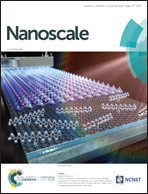A low-temperature-annealed and UV-ozone-enhanced combustion derived nickel oxide hole injection layer for flexible quantum dot light-emitting diodes†
Abstract
Sol–gel derived nickel oxide (NiOx) has been extensively investigated as the hole injection layer (HIL) for many optoelectronic devices because of its advantages of high environmental stability and low cost fabrication. Conventional sol–gel synthesis of NiOx requires high annealing temperature to convert precursors into crystal lattices, which limits its application in flexible devices. To address this issue, a low-temperature (150 °C) combustion method is used to synthesize NiOx. Besides, UV-ozone treatment is further performed to improve the electrical properties of low-temperature-grown NiOx, which leads to the formation of nickel oxyhydroxide (NiO(OH)) surface dipoles and Ni vacancies and thus modifies the energy structure and increases the conductivity of NiOx. Moreover, the formation of surface NiO(OH) induces a vacuum level shift and thus reduces the hole injection barrier. Owing to the enhanced hole injection, solution-processed green QLEDs with optimized UV-ozone treated NiOx HILs exhibit maximum current efficiencies of 45.8 cd A−1 and external quantum efficiencies of 10.9%, which outperform those of the devices with poly(3,4-ethylene dioxythiophene) : poly(4-styrenesulfonate) (PEDOT:PSS) HILs. Meanwhile, these devices also show better long-term stability with a 3.2-fold longer half-life time than that of the PEDOT:PSS-based devices. The demonstrated low-temperature-annealed and UV-ozone enhanced NiOx HILs would enable the realization of flexible QLEDs with high brightness, efficiency and stability.



 Please wait while we load your content...
Please wait while we load your content...